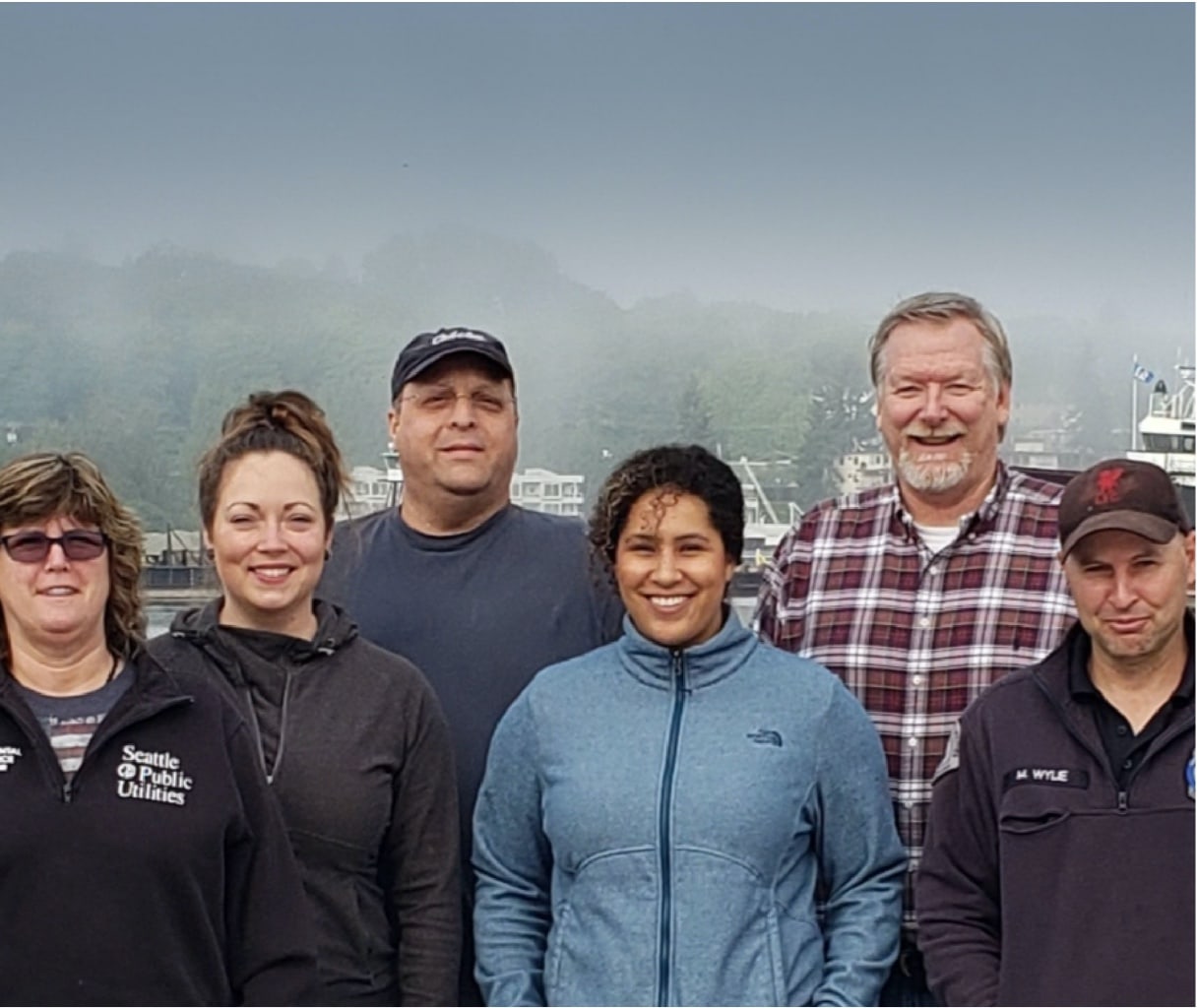
With more than 5,000 restaurants and Food Service Establishments (FSEs) in Seattle, the City’s Fats Oils and Grease (FOG) program is vital to protecting community health and keeping sewers flowing by preventing unlawful discharges from entering the system.
With a team of five inspectors and one program supervisor responsible for a large program, Gary Christiansen, Program Supervisor for the Wastewater Source Control Program (WSCP) at Seattle Public Utilities, needs to optimize on efficiencies wherever possible.
“The reality is our small team is not able to inspect every Food Service Establishment (FSE) immediately; our success depends on identifying problem areas and prioritizing establishments that require the greatest attention. Our overarching goal is to create a data-driven vs. an effort-driven program in order to serve the City of Seattle in a cost effective and efficient manner.” said Christiansen.

Optimizing Existing Programs
For a little over 15 years, the City has used the Aquatic Compliance Platform (ACP), a software program that tracks data from FSEs, as well as ArcGIS that maps sewer lines, connections, and identifies hotspots. The problem was these two systems were not integrated, but if they were, the City could use its GIS system to identify which FSEs were discharging to which service connections and then cross-reference that data with its FOG data. “We realized if we connected these two software solutions, we would be able to better manage our FOG program, automate tasks that were time-consuming, and reduce human error in the process” said Christiansen.
By consolidating GIS and other data into the FOG software, we can get a much more accurate picture of the network, connections to FSEs, and the condition of actual sewers, which really helps us pinpoint problem areas and reduce problems overall.”
Integration of Software Programs
Wastewater Source Control Program staff worked closely with the County Health Department, Food Safety Division to maintain an accurate listing of restaurants. By working with the permitting agency, SPU was able to set up regularly scheduled, automated reports containing the business information about active restaurants, new permits issued, and recently closed permits enabling them to keep their database of over 5,000 restaurants up to date. Once the permit data is received, it is married with the results of SSO, maintenance data, and CCTV findings and uploaded into GIS. To bring the GIS data into the ACP platform, WSCP staff contracted ACP to design and build an import feature to allow for the integration of data between GIS and the FOG software. After a few months, the integration between the FOG software and GIS was complete.
When the City receives the automated reports, data is entered and categorized by the GIS system. The team is then able — at the click of a button — to send information from ArcGIS directly to the ACP database. Previously, this information would have been entered manually and updated annually based on a list of several hundred new facilities.
Integrating the two major software systems allowed certain data elements to be shared between the systems. Now, the FOG software can seamlessly schedule initial inspections for new facilities — and ensure new businesses are not missed. “By consolidating GIS and other data into the FOG software, we can get a much more accurate picture of the network, connections to FSEs, and the condition of actual sewers, which really helps us pinpoint problem areas and reduce problems overall” said Christiansen.
Digitizing Data Entry
Now that the two programs were working well together, Christiansen had a vision to further improve data accessibility and streamline processes by taking the whole program online. “Cloud native applications enable our inspectors to access all of our facility information from the office, in the field, and in the current COVID-19-work environment – from their homes utilizing a laptop or tablet, even their smartphones. We have already experienced the efficiencies of integrating previously-siloed data between the FOG and GIS systems. The first step to taking the program online was to optimize the digitization of processes. Next we intend to move to online maintenance reporting” said Christiansen.
A natural extension for the City was to add ACP Remote Inspector, a software tool that digitizes inspection data and standardizes the data gathered during inspections. “Prior to this, we had paper forms that didn’t have a lot of direct questions and were very text-based,” explained Christiansen. “The inspector would write his or her findings and what they thought was relevant onto these paper-based forms, with no specific direction to ensure basic information was captured.” Often, this led to many more questions by the FSE and corrective actions would require multiple follow-ups before the action could be resolved.
In addition, when hotspots occurred, there were no warnings or indications because no data was available for analysis. Instead, as hotspots were identified, the City would send out inspectors — a reactive approach that meant no preventative steps were being taken, resulting in a backlog of inspections.
The smart forms introduced with Remote Inspector allow inspectors to enter findings into their mobile device directly from the field. By creating standardized digital forms, the City can now quickly and easily specify what data must be collected and build a baseline for better analysis.
Streamlining Risk Assessment
The second instrumental form or process to be digitized was a facility’s FOG risk assessment, which is a ranking based on key factors.
Angelique Hockett, a City FOG inspector who established the Risk Priority Assessment ranking for the FOG program, said, “If we had a Sanitary Sewer Overflow on a main line, that line was given a unique number if SSO and CCTV crews had identified grease. I would then join the lines in the GIS software and a summation of the various criteria would dictate a Hotspot Category per facility. There are 37 different ranking numbers, organized to fit into six hotspot categories.” From there, Hockett would manually assign inspections for each facility using data from the asset management software and its basic information.
Armed with the new smart forms in Remote Inspector, the inspector completes a questionnaire with information observed during the inspection. The form then calculates the results, assigning points to determine the facility’s FOG discharge risk. The smart form combines the FOG discharge risk with the Hotspot category and automatically assigns an overall FOG risk value. Based on the FOG risk value, the software automatically sets a tailored inspection schedule for the facility, allowing SPU to schedule resources in sync with actual need out in the field. Meaning, FSE’s that require more touches are scheduled as such, and those needing less touch are scheduled accordingly as well. “Digitizing this process has improved accuracy and enables us to take preventative action before hotspots occur” concluded Hockett.
Cloud-native applications enable our inspectors to access all of our facility information from the office, in the field, and in the current COVID-19-work environment – from their homes utilizing a laptop or a tablet, even their smartphones

Moving Online
With digitized processes in place, moving the City’s FOG program online has several advantages. Being accessible through a browser, it can now be used on any connected mobile device or computer. The look, feel and function of the software remains consistent, making it easier to use and access the entire suite of FOG software from anywhere. “The uniformity that comes along with a cloud application makes it a lot more efficient and gives us flexibility for the future as the city grows” said Christiansen.

Fostering Partnerships with FSE
Once an inspection has been completed, inspectors can easily email a copy of the completed inspection form to the FSE. Previously, the recipient of the inspection report received a copy of the paper form along with an inspector’s business card. The form included handwritten comments about what corrective actions needed to be taken, which weren’t always clearly stated and required subsequent follow-up visits to ensure action was taken. Now, a report is emailed directly to the FSE with specific corrective action information. From a compliance perspective, this helps ensure all parties clearly understand the City’s expectations. This has helped the City dramatically improve relationships with FSEs. The City can now receive an email with pictures when something is cleaned or corrected, meaning that staff don’t need to go back to the establishment to verify the problem is fixed.
“Since deploying the FOG management software we have been able to increase the number of our inspections by 316% over 4 years. The new program has improved work processes, like route planning and reduced admin time by bringing everything online, so we are able to visit more sites which is a good thing for Seattle’s sewer system” concluded Christiansen.

